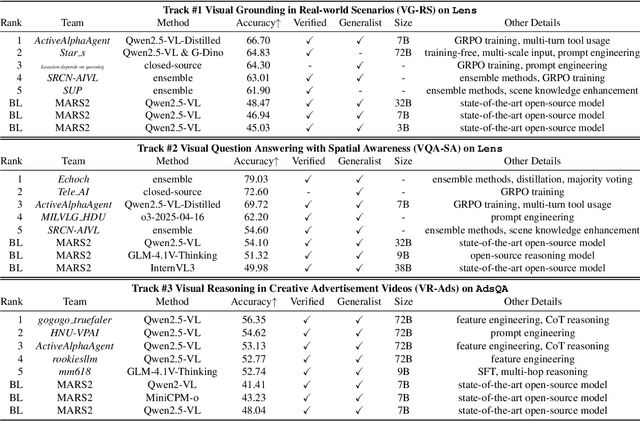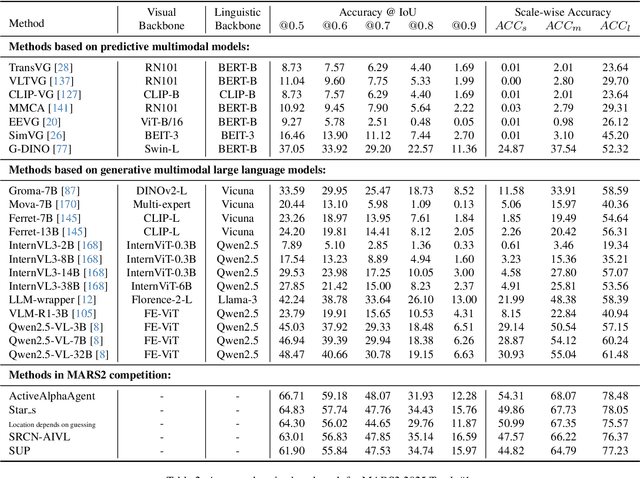Kanggeon Lee
MARS2 2025 Challenge on Multimodal Reasoning: Datasets, Methods, Results, Discussion, and Outlook
Sep 17, 2025



Abstract:This paper reviews the MARS2 2025 Challenge on Multimodal Reasoning. We aim to bring together different approaches in multimodal machine learning and LLMs via a large benchmark. We hope it better allows researchers to follow the state-of-the-art in this very dynamic area. Meanwhile, a growing number of testbeds have boosted the evolution of general-purpose large language models. Thus, this year's MARS2 focuses on real-world and specialized scenarios to broaden the multimodal reasoning applications of MLLMs. Our organizing team released two tailored datasets Lens and AdsQA as test sets, which support general reasoning in 12 daily scenarios and domain-specific reasoning in advertisement videos, respectively. We evaluated 40+ baselines that include both generalist MLLMs and task-specific models, and opened up three competition tracks, i.e., Visual Grounding in Real-world Scenarios (VG-RS), Visual Question Answering with Spatial Awareness (VQA-SA), and Visual Reasoning in Creative Advertisement Videos (VR-Ads). Finally, 76 teams from the renowned academic and industrial institutions have registered and 40+ valid submissions (out of 1200+) have been included in our ranking lists. Our datasets, code sets (40+ baselines and 15+ participants' methods), and rankings are publicly available on the MARS2 workshop website and our GitHub organization page https://github.com/mars2workshop/, where our updates and announcements of upcoming events will be continuously provided.
Auto-regressive transformation for image alignment
May 08, 2025



Abstract:Existing methods for image alignment struggle in cases involving feature-sparse regions, extreme scale and field-of-view differences, and large deformations, often resulting in suboptimal accuracy. Robustness to these challenges improves through iterative refinement of the transformation field while focusing on critical regions in multi-scale image representations. We thus propose Auto-Regressive Transformation (ART), a novel method that iteratively estimates the coarse-to-fine transformations within an auto-regressive framework. Leveraging hierarchical multi-scale features, our network refines the transformations using randomly sampled points at each scale. By incorporating guidance from the cross-attention layer, the model focuses on critical regions, ensuring accurate alignment even in challenging, feature-limited conditions. Extensive experiments across diverse datasets demonstrate that ART significantly outperforms state-of-the-art methods, establishing it as a powerful new method for precise image alignment with broad applicability.
StreamMultiDiffusion: Real-Time Interactive Generation with Region-Based Semantic Control
Apr 01, 2024



Abstract:The enormous success of diffusion models in text-to-image synthesis has made them promising candidates for the next generation of end-user applications for image generation and editing. Previous works have focused on improving the usability of diffusion models by reducing the inference time or increasing user interactivity by allowing new, fine-grained controls such as region-based text prompts. However, we empirically find that integrating both branches of works is nontrivial, limiting the potential of diffusion models. To solve this incompatibility, we present StreamMultiDiffusion, the first real-time region-based text-to-image generation framework. By stabilizing fast inference techniques and restructuring the model into a newly proposed multi-prompt stream batch architecture, we achieve $\times 10$ faster panorama generation than existing solutions, and the generation speed of 1.57 FPS in region-based text-to-image synthesis on a single RTX 2080 Ti GPU. Our solution opens up a new paradigm for interactive image generation named semantic palette, where high-quality images are generated in real-time from given multiple hand-drawn regions, encoding prescribed semantic meanings (e.g., eagle, girl). Our code and demo application are available at https://github.com/ironjr/StreamMultiDiffusion.
MEIL-NeRF: Memory-Efficient Incremental Learning of Neural Radiance Fields
Dec 31, 2022



Abstract:Hinged on the representation power of neural networks, neural radiance fields (NeRF) have recently emerged as one of the promising and widely applicable methods for 3D object and scene representation. However, NeRF faces challenges in practical applications, such as large-scale scenes and edge devices with a limited amount of memory, where data needs to be processed sequentially. Under such incremental learning scenarios, neural networks are known to suffer catastrophic forgetting: easily forgetting previously seen data after training with new data. We observe that previous incremental learning algorithms are limited by either low performance or memory scalability issues. As such, we develop a Memory-Efficient Incremental Learning algorithm for NeRF (MEIL-NeRF). MEIL-NeRF takes inspiration from NeRF itself in that a neural network can serve as a memory that provides the pixel RGB values, given rays as queries. Upon the motivation, our framework learns which rays to query NeRF to extract previous pixel values. The extracted pixel values are then used to train NeRF in a self-distillation manner to prevent catastrophic forgetting. As a result, MEIL-NeRF demonstrates constant memory consumption and competitive performance.
 Add to Chrome
Add to Chrome Add to Firefox
Add to Firefox Add to Edge
Add to Edge